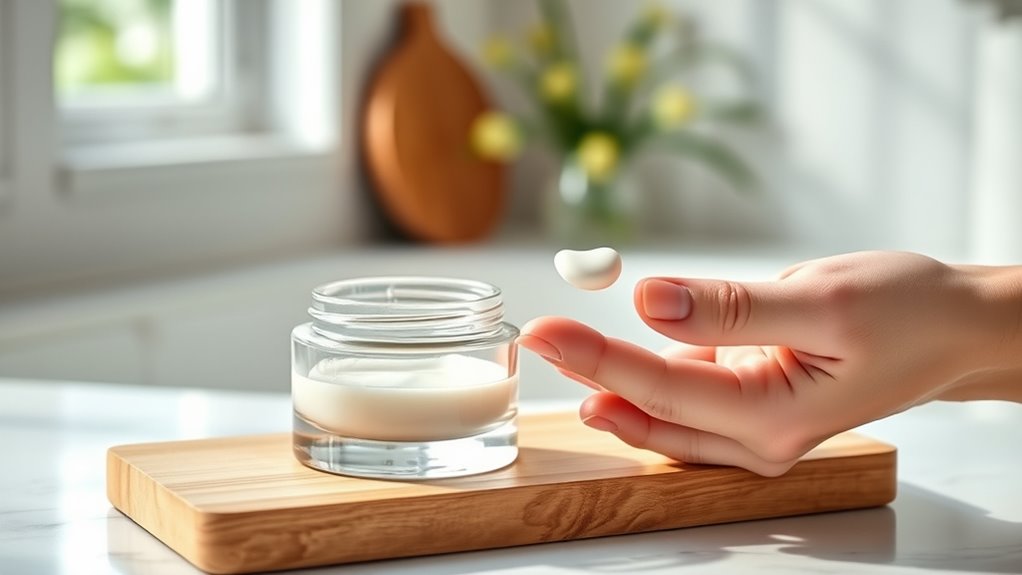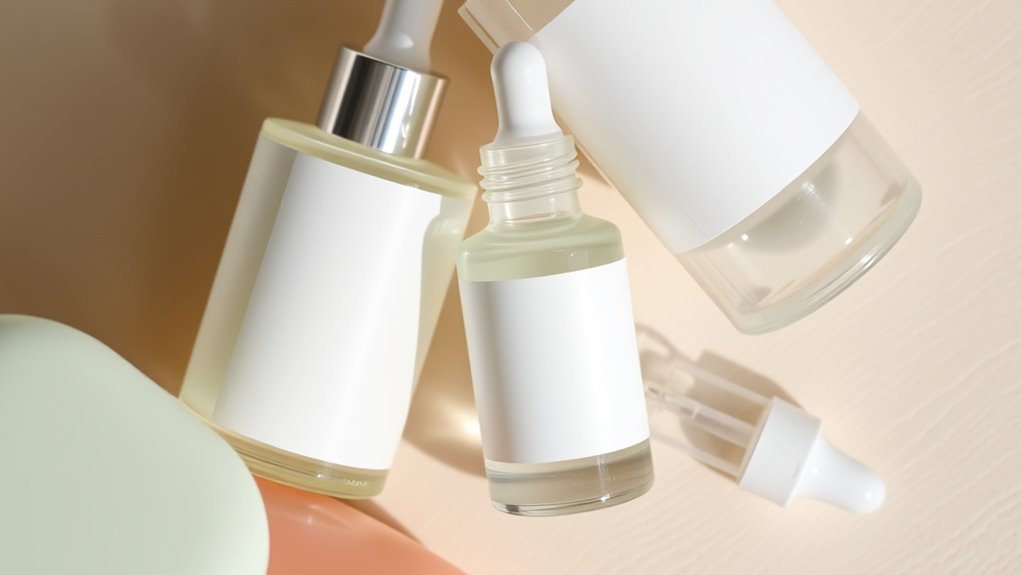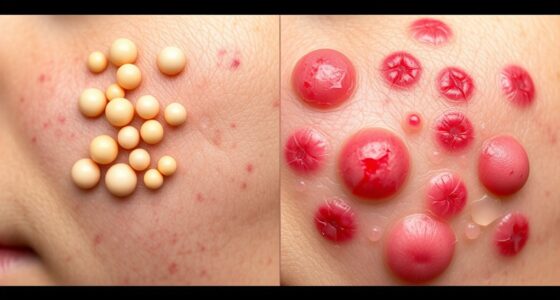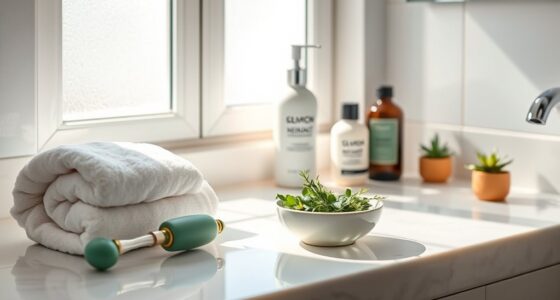Starting retinoids can transform your skin but it’s best to begin slowly to reduce irritation. Use a small amount a few nights a week, and gradually increase as your skin gets used to it. Always apply a gentle moisturizer afterward and wear broad-spectrum sunscreen daily, even if you don’t go outside. Pay attention to your skin’s response and adjust your routine as needed. Keep going, and you’ll discover key tips to make your retinoid journey comfortable and effective.
Key Takeaways
- Start with a low concentration retinoid a few times weekly to minimize irritation.
- Always apply retinoids on dry skin and wait several minutes before moisturizing.
- Use retinoids at night and apply broad-spectrum sunscreen every morning.
- Gradually increase frequency and strength as your skin adjusts to reduce side effects.
- Incorporate hydrating and gentle skincare to support skin barrier and prevent dryness.

If you’re new to skincare, retinoids can seem intimidating, but they’re powerful tools for improving your skin’s texture and reducing signs of aging. The key is to start slowly and understand how to use them properly to minimize any discomfort or unwanted effects. One of the most common concerns with retinoids is the potential for clinical side effects, which can include dryness, redness, peeling, or irritation. These reactions are normal when your skin is adjusting but can be managed with proper application tips. For instance, applying a small amount of retinoid just a few times a week initially helps your skin build tolerance. It’s best to start with a low concentration, especially if you have sensitive skin, and gradually increase use as your skin adapts. Additionally, choosing a retinoid formulation suited for beginners can help reduce the risk of adverse reactions.
Application tips are essential for getting the most benefit from retinoids without overwhelming your skin. Always wash your face with a gentle cleanser and pat it dry before applying. Wait a few minutes to ensure your skin is completely dry, as applying retinoids on damp skin can increase irritation. Use a pea-sized amount and spread it evenly over your face, avoiding the delicate skin around your eyes. If you’re unsure, consult product instructions or a dermatologist for guidance on application frequency. It’s also beneficial to incorporate retinoids into your nighttime routine because they can increase your skin’s sensitivity to sunlight. Remember to apply a broad-spectrum sunscreen every morning, even on cloudy days, to protect your skin from UV damage, which retinoids can make more vulnerable. Recognizing skin sensitivity and adjusting your routine accordingly can help you use retinoids safely and effectively.
Another helpful application tip is not to layer retinoids with other strong skincare ingredients, like alpha hydroxy acids or vitamin C, at least initially. This can reduce the risk of irritation. If you want to use these ingredients, do so on alternate nights until your skin adjusts. Additionally, watch for signs of over-exfoliation or excessive dryness, and if they occur, cut back on retinoid use or switch to a milder formulation. Hydrating your skin with a gentle moisturizer can also help counteract dryness and soothe irritation.
Frequently Asked Questions
Can Retinoids Be Used on Sensitive Skin Types?
Yes, you can use retinoids on sensitive skin types, but you should proceed with caution. Start with a lower concentration to minimize irritation and strengthen your skin barrier. Be mindful of ingredient sensitivity, as retinoids can cause redness or dryness initially. Always patch test first, and consider applying retinoids less frequently until your skin adjusts. Using a gentle moisturizer can help protect your skin and reduce potential irritation.
How Long Does It Take to See Results With Retinoids?
You might start noticing changes in your skin’s texture and tone in about 4 to 6 weeks, but real results often take 8 to 12 weeks. Think of it as planting a seed; patience is key. Your skin needs time to adjust and reveal improvements. Stay consistent, keep your expectations realistic, and give your skin the patience it requires to see those visible, radiant transformations unfold gradually.
Are There Natural Alternatives to Retinoids for Beginners?
Yes, there are natural alternatives to retinoids for beginners. You might try plant-based ingredients like rosehip seed oil, which contains natural vitamin A, or herbal remedies such as chamomile and calendula, known for soothing skin and promoting healing. These options can help improve skin texture and brightness gently, making them ideal for those new to skincare or sensitive skin. Always patch test before fully incorporating new remedies into your routine.
Can Retinoids Be Combined With Other Skincare Products Safely?
Think of product layering like assembling a vintage radio—you want the parts to work harmoniously. Yes, you can combine retinoids with other skincare products safely, but focus on ingredient compatibility. Use gentle, hydrating products first, then apply retinoids. Avoid mixing retinoids with strong acids or vitamin C to prevent irritation. Always patch test new combos to guarantee your skin stays happy and balanced on its skincare journey.
What Should I Do if I Experience Severe Irritation?
If you experience severe irritation, stop using the retinoid immediately. Do a patch test on a small skin area to check if your skin reacts badly. Apply a gentle moisturizer and avoid harsh products. It’s important to consult a dermatologist promptly for personalized advice and to guarantee your skin heals properly. Always follow their guidance to prevent further irritation and protect your skin’s health.
Conclusion
Starting with retinoids might feel like stepping into uncharted waters, but remember, patience is your best compass. As you ease into their routine, you’ll discover they’re like a gentle rain—gradually transforming your skin without overwhelming it. Stick with it, follow your dermatologist’s advice, and give your skin time to adjust. With consistency, you’ll see your skin blossoming into a healthier, more radiant version of itself—like a garden finally blooming after a long wait.









